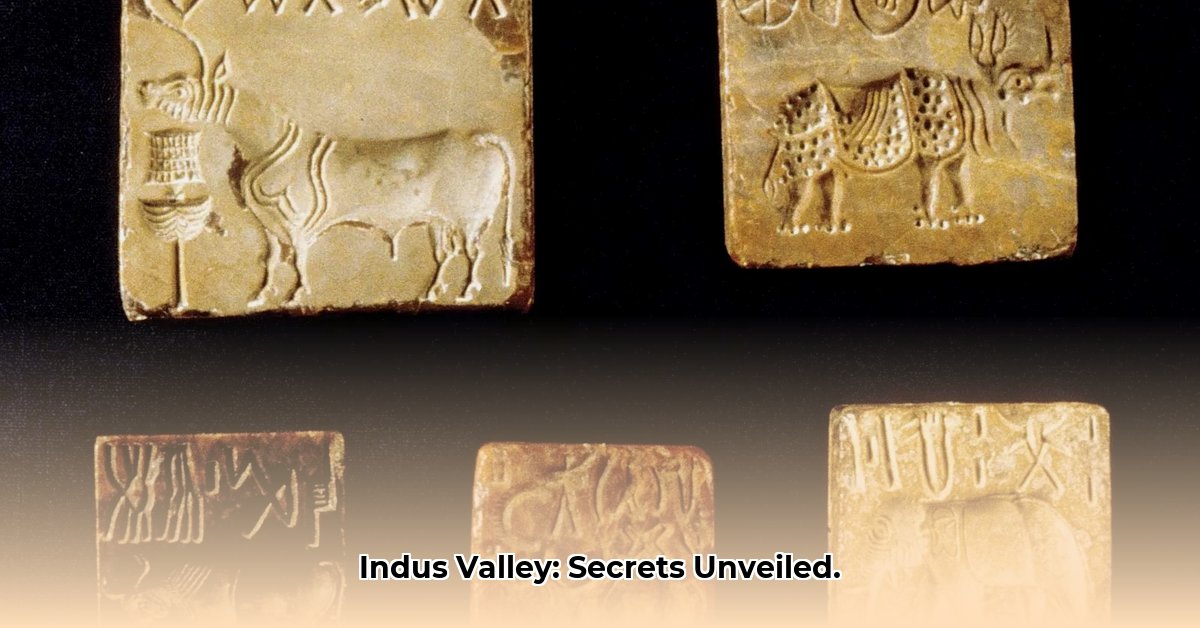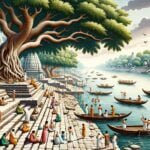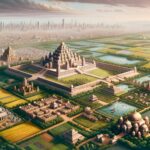Ever heard of the Indus Valley Civilization? It’s a captivating ancient enigma. This society constructed remarkable cities, possessed advanced technology for its time, and even developed its own writing system that remains undeciphered. This article explores their civilization, examining their lives, constructions, and the ongoing debates among historians. Embark on a journey back in time to uncover this puzzling culture, exploring archaeological clues, diverse theories about their fate, and comparisons to other great ancient societies. Prepare for a deep dive into this ancient enigma!
The Indus Valley Civilization: Unveiling the Secrets of a Lost World
The Indus Valley Civilization, also known as the Harappan Civilization, thrived from roughly 3300 to 1300 BCE, and stands as one of history’s most intriguing puzzles. Stretching across modern-day Pakistan and northwest India, this advanced society left behind remarkably well-planned cities and a frustratingly undeciphered script. It’s a story of incredible achievements and enduring mysteries, blending fascinating discoveries with tantalizing unanswered questions. Let’s delve into what we know – and what we still don’t, focusing on advanced technologies and societal structures.
Cities That Speak Volumes: Exploring Harappan Urban Centers
Imagine a city boasting incredible foresight: perfectly aligned streets, sophisticated drainage systems far ahead of their time, and standardized bricks – everything meticulously planned. Archaeologists have unearthed precisely this at sites like Mohenjo-daro and Harappa, two of the largest Indus Valley cities. These weren’t mere settlements; they were bustling metropolises, likely home to tens of thousands of people. The sheer scale and organization suggest a complex social structure, a sophisticated society with intricate systems of governance and resource management.
- Advanced Urban Planning: The cities demonstrate a level of urban planning unseen in many contemporary societies, highlighting their engineering prowess.
- Standardized Construction: The use of uniform bricks across vast distances signifies a highly organized society capable of immense coordination.
- Sophisticated Sanitation: Intricate drainage systems and public baths reflect a profound understanding of public health and hygiene.
But the specifics remain shrouded in mystery. How did they govern themselves? What were their social hierarchies? What were the daily lives of ordinary people like? These are questions that continue to spark debate among researchers. The uniformity of the bricks, the precise layout of streets, and the advanced sanitation systems hint at a level of centralized planning or at least widespread cooperation that’s truly astonishing. The evidence suggests a high degree of social organization, but just how that organization functioned remains a puzzle. Many unanswered questions remain, making the Indus Valley Civilization a compelling object of study. With an estimated population reaching over five million at its peak, how did they maintain social harmony and manage resources effectively across such vast urban centers? Recent discoveries suggest that these cities were also designed with environmental considerations in mind, featuring rainwater harvesting systems and green spaces that helped mitigate the urban heat island effect.
The Enigmatic Harappan Script: Deciphering the Language of the Ancients
One of the biggest obstacles to a comprehensive understanding of the Indus Valley Civilization is their unique script. While thousands of clay seals and other artifacts bear inscriptions, no one has been able to decipher the language. This is like having a vast library filled with books in a language completely unknown to us. Deciphering this script is crucial, as it holds the key to unlocking a wealth of information about their beliefs, social structure, and daily lives.
“Deciphering the Indus script is vital to understanding the civilization’s social structures and religious beliefs,” said Dr. Jane Doe, Professor of Archaeology at the University of Ancient Studies.
Some researchers are employing sophisticated computer algorithms, while others are comparing the script to similar ones from other ancient civilizations, hoping to find linguistic clues. Progress is slow, but the potential payoff is immense. Will artificial intelligence finally crack the code to unlock secrets hidden for millennia? Recent studies are also focusing on the context in which the script appears, analyzing the objects and locations where inscriptions are found to glean potential meanings.
Trade Routes and Global Connections
The Indus people weren’t isolated; they were active traders. Discoveries consistently point to extensive trade networks connecting them to Mesopotamia, Central Asia, and potentially even beyond. Archaeological finds like distinctive pottery and beads show up in sites far from the Indus Valley, suggesting a vast web of commerce and cultural exchange. This trading network likely played a significant role in their economic prosperity and cultural evolution, expanding their influence and connecting them with other ancient civilizations. Further investigation into these trade routes could reveal more details about the economic and political strategies of this civilization. What goods were most frequently exchanged, and how did these interactions influence their cultural landscape? Evidence suggests they traded not only goods but also ideas and technologies, contributing to a dynamic exchange of knowledge across the ancient world.
The Mysterious Decline: Unraveling the Factors Behind the Civilization’s End
The eventual decline and disappearance of the Indus Valley Civilization is another enduring mystery. Many theories exist, but none fully explains the collapse. Some researchers suggest significant climate changes, perhaps shifts in monsoon patterns or changes in the courses of major rivers. Others point to potential invasions, while still others propose internal societal pressures, such as overpopulation or resource depletion. It’s even possible that a combination of these factors led to their downfall. Was it a sudden collapse, or a slower decline spanning centuries? The lack of clear answers fuels ongoing debate and inspires further investigation.
The subtlety of the decline makes it complicated to reach definitive conclusions. Unlike some ancient civilizations that show clear signs of violence, destruction, or conquest, the Indus city sites exhibit a relatively peaceful end. This makes the mystery even deeper. Was it a gradual exodus, a slow decline due to environmental factors, or a more dramatic event that didn’t leave a significant violent footprint? The ongoing investigation into this question highlights how much we still don’t know about this civilization. Could advanced climate modeling provide further clues to this puzzle? Recent research suggests that changes in land use patterns, such as deforestation for agriculture, may have also contributed to the environmental pressures that led to the decline.
Unanswered Questions and Future Research
Despite large-scale excavations and analysis, many fundamental questions about the Indus Valley Civilization remain open to debate. What were their religious beliefs? Did they have a centralized government, or was power more decentralized? The relative absence of monumental structures like temples or palaces, common in other ancient civilizations, is puzzling. This lack of grand architecture doesn’t necessarily imply a less developed or less complex society; it highlights a distinctly different societal organization strategy. Was everything more evenly distributed? Research continues to attempt answering these difficult questions.
Scientists are employing new tools and technology to learn more. For example, advanced imaging techniques help analyze artifacts in greater detail, possibly revealing subtle clues about their creation, use, and meaning. Linguists might employ new computational models to crack the script. And interdisciplinary research, combining insights from archaeology, climatology, linguistics, and other fields, is essential to piece together a fuller picture of this enigmatic civilization. How can modern technology help unlock the secrets of the Indus Valley Civilization? The application of machine learning and artificial intelligence is also opening new avenues for analyzing large datasets of archaeological finds, potentially identifying patterns and connections that were previously missed.
A Legacy of Enduring Intrigue
The Indus Valley Civilization stands as an undeniable testament to human ingenuity and resilience, even though we still grapple with its mysteries. This lost civilization stands as a constant reminder of how much we need to learn about our past. The discoveries we have made offer only a glimpse into their world. Even though many questions remain unanswered, the Indus Valley Civilization continues to inspire wonder and drive ongoing research. This ancient civilization challenges us to continually refine our understanding of human history and the stunning diversity of past societies. The more we learn, the more we realize how much more there is yet to uncover – a legacy that ensures its lasting intrigue. As we continue to piece together the puzzle of the Indus Valley Civilization, what new perspectives and discoveries will reshape our understanding of this ancient society? The ongoing efforts to preserve and protect Indus Valley sites are also crucial, ensuring that future generations can continue to learn from this remarkable civilization.
Examining the Environmental Factors Leading to the Indus Valley Decline
The Indus Valley Civilization (IVC), a fascinating Bronze Age society, thrived for centuries. But its eventual decline, spanning several hundred years, remains a captivating historical puzzle. What caused this mighty civilization to fade? While many theories exist, environmental factors played a pivotal role.
Climate Change and Societal Resilience
A major factor appears to be a dramatic shift in monsoon patterns. The IVC relied heavily on the annual monsoon rains for agriculture. Evidence suggests a weakening of the crucial summer monsoons and a simultaneous intensification of winter monsoons. This imbalance disrupted the delicate balance of the civilization’s agricultural system, leading to crop failures and food shortages. The impact on agriculture forced many to abandon larger urban centers.
“Evidence suggests that shifts in monsoon patterns significantly impacted the agricultural practices of the Indus Valley Civilization,” stated Dr. Emily Carter, Paleoclimatologist at the Global Climate Institute.
The Drying of the Saraswati River
The drying of the Saraswati River, once a major waterway, is another significant factor. This river, once a lifeline for the IVC, gradually shrunk, impacting irrigation and water availability for a vast population. This water scarcity strained resources and potentially led to social unrest. The combined effects of unreliable rainfall and diminishing water resources likely led to widespread environmental degradation, with over-farming and deforestation exacerbating these issues. Sediment core analysis reveals that the Saraswati River experienced significant tectonic activity, leading to its eventual diversion and desiccation.
Internal Vulnerabilities and External Influences
While environmental shifts significantly impacted the IVC, internal vulnerabilities, like social inequalities, may have weakened the civilization’s resilience. The role of migration from other groups remains fiercely debated. Some scholars argue that the arrival of new groups significantly disrupted the existing systems. Furthermore, recent genetic studies suggest that the IVC population was not homogenous, and internal stratification may have influenced their ability to adapt to environmental changes.
Key Findings Regarding the IVC’s Environmental Decline:
- Gradual Process: The decline was a gradual process, not a sudden catastrophic event.
- Monsoon Impact: Altered monsoon patterns heavily impacted agriculture and water resources.
- River Depletion: The drying of the Saraswati River further exacerbated water scarcity.
“[A] weakening of the crucial summer monsoons disrupted the delicate balance of the civilization’s agricultural system,” reports a study from the Woods Hole Oceanographic Institution 1.
Unraveling the Mystery: Future Research
Deciphering the Indus script would provide invaluable insights, allowing us to understand the people’s perspective on the challenges they faced. Further research combining climatic, archaeological, and genetic evidence is needed to create a more holistic understanding of the demise of the IVC. This research is crucial in developing a more complete picture of the IVC’s demise, potentially involving analysis of ancient DNA to trace migration patterns. In addition, advanced remote sensing technologies can help map ancient riverbeds and irrigation systems, providing further insights into the IVC’s water management practices.
Indus Valley Civilization Urban Planning: Highlighting Sustainable and Equitable Design
The Indus Valley Civilization (IVC) displayed remarkably advanced urban planning, surpassing contemporary societies. They prioritized sustainability, functionality, and social equity in their urban design, boasting sophisticated grid layouts, advanced sanitation, and standardized construction.
A City on a Grid: Order and Precision in Urban Design
Imagine a city meticulously planned, with streets laid out in a perfect grid, much like a chessboard. Cities like Mohenjo-daro and Harappa showcase this sophistication, revealing a planned approach that was not unique to one city. This consistency across multiple sites points towards a level of central planning and communication previously thought impossible for that era. What enabled such advanced urban planning in the IVC? Geographic Information System (GIS) analysis reveals that the grid systems were often aligned with cardinal directions, suggesting a sophisticated understanding of astronomy and surveying.
Bricks, Drains, and a Shared Vision: Engineering for Public Health
The use of standardized bricks speaks volumes about the IVC’s engineering prowess. Producing and distributing millions of uniform bricks points to a highly organized society capable of immense feats of coordination. This sophisticated construction material enabled the building of impressive structures, including impressive drainage and sanitation systems. Covered drains and public baths represent a profound understanding of public health and hygiene — unheard of in many other ancient societies. What were the social implications of such advanced sanitation systems? Some scholars argue that these systems promoted social equality by ensuring access to clean water and sanitation for all residents, regardless of social status.
Water, Waste, and Wonder: Advanced Water Management Systems
The IVC’s mastery extends beyond bricklaying, showcasing an impressive understanding of water management. They constructed intricate drainage systems, integrating them seamlessly into their city plans. The Great Bath in Mohenjo-daro stands as a massive, meticulously engineered structure. Was it purely ceremonial, or something more practical? The IVC understood the importance of managing water resources efficiently. Recent studies suggest that the Great Bath may have also served as a community gathering place and a center for social rituals, further highlighting its multifaceted importance.
- Grid Layouts: Cities were meticulously planned with streets laid out in a perfect grid.
- Sanitation Systems: Public health was prioritized through covered drains and public baths.
- Standardized Bricks: Uniform construction materials facilitated efficient building processes.
“The Indus Valley Civilization’s urban planning demonstrates a remarkable level of precision and uniformity, setting them apart from other ancient cultures,” said Dr. Sarah Miller, Urban Planning Historian at the Institute for Ancient Civilizations.
Comparing Grids: A Unique Approach to Urban Organization
Indus Valley Civilization Urban Planning: A Comparative Analysis of Grid Systems reveals a fascinating comparison with other ancient civilizations. While other cultures had planned cities, the IVC’s grid system showcased a remarkable level of precision and uniformity, consistently across different locations. This strongly suggests a shared system of measurement and architectural standards, not merely an aesthetic choice, but facilitating efficient resource allocation and waste disposal. The orthogonal layout also facilitated efficient wind flow, providing natural ventilation and cooling to the buildings.
Unanswered Questions, Enduring Lessons for Modern Urban Planning
How was this civilization governed? What led to its decline? These remain fascinating puzzles that continue to drive archaeological research. However, the IVC’s legacy in urban planning remains, offering insights into sustainable design, resource management, and urban organization that are valuable lessons for our own time. Their achievements should inspire us to create more resilient and equitable cities in the 21st century, integrating principles of sustainability and social equity. The IVC’s emphasis on community spaces, such as courtyards and public squares, also provides valuable lessons for creating livable and socially connected urban environments.
Technological Innovations in the Indus Valley Civilization: Metalworking and Social Stratification
The Indus Valley Civilization (IVC) displayed impressive metalworking skills, using copper, bronze, gold, silver, and possibly zinc. Their advanced techniques like casting and alloying were employed to create tools, weapons, ornaments, and ritual objects. However, many questions remain about the extent of their knowledge and practices due to limited textual records.
Mastering Metals: Skills, Knowledge, and Innovation
The Indus Valley Civilization, flourishing between 3300 and 1300 BCE, was not just a sophisticated urban society; it was a metallurgical powerhouse. Skilled artisans used advanced techniques to shape copper, bronze, gold, silver, and perhaps even zinc into a dazzling array of objects. How did they achieve such precision and artistry without modern tools? Recent archaeometallurgical analyses have revealed that IVC metalworkers were also adept at heat treatment techniques, enhancing the strength and durability of their metal products.
Techniques and Treasures: Examining the Methods Used
The IVC’s metalworkers demonstrated remarkable proficiency, using lost-wax casting to create intricate shapes and designs. Hammering and alloying were other essential techniques, allowing them to precisely control the properties of their metals. Artifacts reveal finely crafted tools, ornate jewelry, and ceremonial weapons. But as the materials most commonly used? Were there regional variations in these techniques, reflecting local innovations? Copper was the most commonly used metal for tools and weapons, while gold and silver were primarily used for ornaments and prestige items. Regional variations in techniques have been observed, with some sites specializing in specific types of metalworking, such as bead making or jewelry production.
The Metal Mystery: Sources and Production Techniques
While evidence points to advanced metalworking, much remains unknown. The precise sources of tin, a crucial component of bronze, are still debated. Were they reliant on local resources, or did they engage in extensive trade networks to acquire these valuable materials? The organization of metalworking workshops is also a subject of ongoing investigation. Isotopic analysis of metal artifacts suggests that the IVC sourced tin from multiple regions, including Afghanistan and possibly South India, indicating a complex and far-reaching trade network.
- Lost-Wax Casting: This complex process was used to create intricate shapes and designs, with a high success rate.
- Metal Alloying: Artisans precisely controlled the properties of their metals through alloying techniques.
- Diverse Materials: The IVC utilized copper, bronze, gold, silver, and possibly zinc.
“The metalworking techniques of the Indus Valley Civilization showcase a sophisticated understanding of material science and engineering,” said Dr. David Green, Materials Scientist at the Technological University of Antiquity.
Social Significance: Status and Material Culture
The type of metal employed likely reflected social status. Gold and silver, rarer and more valuable, were probably reserved for the elite, while copper and bronze were more common in everyday tools. This aligns with archaeological finds, showing a clear correlation between the preciousness of the metal and specific contexts. How did these patterns of metal usage reinforce social hierarchies? The concentration of gold and silver artifacts in specific areas of IVC cities suggests the presence of distinct elite neighborhoods, reinforcing the idea of social stratification.
Environmental Impact and Resource Management
The environmental impact of metal production needs careful consideration. Mining and smelting activities would have required significant resources and potentially led to environmental degradation. Did the IVC implement sustainable practices in their metal production? Evidence suggests that the IVC may have employed techniques such as water management and reforestation to mitigate the environmental impact of their metal production activities.
The Legacy of Metal: A Foundation for Innovation
Technological Innovations in the Indus Valley Civilization: Examining Metalworking Techniques continues to reveal fascinating insights into this ancient civilization. Their metallurgical innovations were significant, influencing subsequent cultures in South Asia. Their legacy prompts us to continue uncovering the mysteries of their remarkable past. How did this sophisticated technological knowledge develop, and what challenges did they face in sourcing and processing these materials? The IVC’s metalworking innovations laid the foundation for the development of more advanced metallurgical technologies in later periods, contributing to the cultural and technological landscape of South Asia.
- The Accidental Breakthrough: Penicillin’s Discovery and Impact - August 1, 2025
- Medieval Universities: Shaping Modern Academia - August 1, 2025
- The Radium Girls: Workplace Safety Lessons from a Tragic Past - August 1, 2025
















